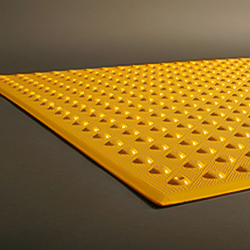









Ensuring accessibility compliance of indoor spaces is crucial, but maintaining it over the long run requires diligent effort. While proper selection of code-compliant tactile solutions from the outset helps achieve accessibility, consistent upkeep is equally important for continued safe navigation. This blog outlines best practices for facilities managers, contractors, and building owners to reliably sustain accessibility standards indoors through regular maintenance routines.
The Accessibility for Ontarians with Disabilities Act (AODA) and Ontario Building Code (OBC) mandate that public spaces be barrier-free for all individuals. Tactile walking surface indicators (TWSIs), like truncated dome tiles, caution drop-offs while parallel bars delineate designated paths. Proper placement, as per the Canadian Standards Association (CSA) B651, helps the visually impaired orient independently.
Regular post-occupancy assessments verify adherence. Non-compliance can result in hefty penalties or liability lawsuits if someone gets injured. It is thus prudent to proactively maintain installed solutions and promptly address defects. Renew tactile beforehand rather than reacting to non-compliance notices.
The first step is having standardized inspection checklists capturing all essential tactile product details as per applicable codes. Inspect dome height, bond integrity, visual clarity, alignment, cleanliness, and signage legibility regularly based on traffic volumes. High-usage areas need monthly checking, while low-traffic zones can be biannual.
Record observations with dated images for documenting remedial work quality over time. Note defective locations, annual replacement areas, and solutions nearing lifespan's end. Community audits provide user feedback. Partnering inspection experts ensures comprehensive, consistent audits adhering to prescribed procedures.
When selecting initial or replacement solutions, choose products rated for 10-15 years of durability under typical indoor conditions. Consider application, surface material, aesthetics, and costs.
Porcelain tiles withstand decades of use but require proper bonding to the floors.
Composite polymer tiles balance compliance, longevity, and affordability for most spaces.
Rubber tiles suit healthcare and transit centers experiencing footfall 24/7.
Cast iron/metal tiles embed permanently into new concrete for 20+ year lifespans.
Choose surface-applied or embeddable variants and truncated dome, parallel bar, or combined textures suiting the specific environment's designated hazardous areas and routes according to codes.
Partner with expert tactile suppliers to advise on ideal solutions meeting your unique building needs and traffic intensities. Their technical support aids in correct specification and installation for ongoing accessibility.
With accessibility-critical tactile infrastructure implemented, the focus shifts to establishing maintenance best practices sustaining compliance long-term:
Schedule semi-annual deep cleaning of all tactile tiles and replace severely soiled units.
Inspect post renovation/construction to verify tactiles weren't disturbed or need realignment.
Conduct post-event walkthroughs after major gatherings/functions.
Review biannual condition assessments and proactively replace aging solutions before failure.
Note remedial repairs from periodic inspections and address them promptly.
Outsource annual specialty audits measuring dome height to experts.
Train cleaning/maintenance staff in tactile product care and notifying upcoming replacements.
Partnering supplier maintenance agreements provides turnkey support encompassing everything from periodic inspection to material supply for ad-hoc repairs and scheduled replacements. This guarantees continued accessibility over decades.
Accessibility compliance maintenance faces occasional hurdles. Proper protocols overcome such challenges:
Budget constraints: Prioritize high-footfall zones and leverage community audits/supplier relationships for cost-effective solutions.
Staffing issues: Outsource specialized tasks temporarily or upskill in-house teams through accessibility certification courses.<b>Renovations: Specify tactile relocation/replacement plans well in advance and inspect pre/post-occupancy.
Damage from events: Enhance maintenance post large public programs to restore tactile promptly.
When proactively addressing such compliance maintenance roadblocks through collaborative partnerships, facilities reliably protect accessibility achievements for all.
Prepare contingency plans addressing urgent code issues efficiently:
Stock maintenance inventory of common tactile products
Secure emergency funding/services pre-approval
Assign trained staff to oversee immediate corrections
Comply with accessibility legislation timelines for corrections
Proactively mitigating compliance risks future-proofs the user experience and minimizes legal liabilities.
As a trusted accessibility solutions provider, Tactile Solution Canada offers various indoor tactile product options suitable for both new construction and renovated facilities across Canada:
AccessTile Replaceable and ArmorTile Cast-In-Place polymer composite tiles balance strength, customization, and cost-effectiveness for most indoor applications.
Porcelain ElanTile adds aesthetic elegance to commercial lobbies while exceeding durability standards.
AccessTile Fire-rated composite systems satisfy strict codes for exit pathways, vestibules, and lobbies which is compulsory to install on buildings with 7 or more floors.
Rubber EonTile suits office buildings and apartment buildings experiencing intense footfall.
Cast iron/metal plates guarantee 20+ year lifespans when embeddable into concrete floors.
Backed by technical expertise, the company can advise on ideal tactile solutions for your facility, specify them as per unique criteria, and provide maintenance support to optimize accessibility in the long term.
A. Quality indoor tactile tiles typically last 10-15 years. Those in heavy traffic zones may need replacing every 5-8 years. Semi-annual inspections help assess product condition and proactively schedule replacements.
A. Routine semi-annual deep cleaning removes accumulated dirt, debris, or residues. Inspect post any floor work to ensure tactile weren't disturbed. Promptly address defects from periodic inspections.
A. Prioritize high-traffic areas and leverage community audits. Outsource specialized inspection/auditing tasks temporarily. Partner with suppliers experienced in cost-effective compliance solutions.
Sustaining indoor accessibility requires diligent, proactive efforts. By developing comprehensive inspection-maintenance protocols and tapping resources from experts, facilities can reliably maintain compliance for all users over the long run. Tactile Solution Canada assists contractors in achieving this goal every step of the way.
